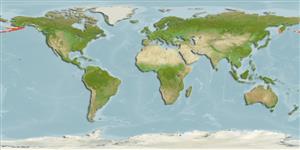Common names from other countries
>
Perciformes/Scorpaenoidei (Scorpionfishes) >
Sebastidae (Rockfishes, rockcods and thornyheads) > Sebastinae
Etymology: Sebastes: Greek, sebastes = august, venerable (Ref. 45335); ciliatus: Name from Latin 'ciliatus' meaning 'eyelash' (Ref. 27436) or 'eyelid', referring to the numerous accessory scales (similar to fringing eyelashes) on the psoterior field of the larger scales in most species of Sebastes (Ref. 53613).
Environment: milieu / climate zone / depth range / distribution range
Ecologia
marinhas demersal; intervalo de profundidade 5 - 160 m (Ref. 53613). Temperate; 58°N - 50°N
North Pacific: western Aleutian Islands and eastern Bering Sea, through the Gulf of Alaska, to southeast Alaska; including south to Johnstone Strait, British Columbia.
Length at first maturity / Tamanho / Peso / Idade
Maturity: Lm 29.0 range ? - ? cm
Max length : 53.0 cm TL macho/indeterminado; (Ref. 27437); peso máx. Publicado: 1.8 kg (Ref. 40637); Idade máx. registada: 67 anos (Ref. 39247)
Descrição breve
Chaves de identificação | Morfologia | Morfometria
Espinhos dorsais (total) : 13; Raios dorsais moles (total) : 15; Espinhos anais: 3; Raios anais moles: 8. Head spines weak to very weak - nasals usually present, parietals usually absent, preocular, supraocular, postocular, tympanic, coronal and nuchal spines absent (Ref. 27437). Two distinct types, (1) dark dusky - uniformly dark or dusky in color, symphyseal knob absent and, (2) light dusky - a larger, greenish brown fish, lighter ventrally, fins tinged with pink or orange, symphyseal knob present (Ref. 27437). Caudal fin slightly indented (Ref. 6885).
Found hovering in loose organized groups just above rocky reefs and along shorelines, or may rest singly upon rocky substrate (Ref. 27436). Feed by picking and seizing food items that are either drifting or suspended in the water column (Ref. 27302). Viviparous (Ref. 34817). Sold as fresh or frozen fillets; eaten as fish cakes (Ref. 27436). Captured by the nearshore jig fishery and has been reported to comprise up to 25% of the catch in the 'black rockfish' jig fishery of the northern Gulf of Alaska (citation in Ref. 53613).
Life cycle and mating behavior
Maturities | Reprodução | Spawnings | Egg(s) | Fecundities | Larvas
Eschmeyer, W.N., E.S. Herald and H. Hammann, 1983. A field guide to Pacific coast fishes of North America. Boston (MA, USA): Houghton Mifflin Company. xii+336 p. (Ref. 2850)
Categoria na Lista Vermelha da IUCN (Ref. 130435)
CITES (Ref. 128078)
Not Evaluated
Ameaça para o homem
Harmless
Utilização humana
Pescarias: pouco comercial; peixe desportivo: sim
Ferramentas
Relatórios especiais
Descarregue XML
Fontes da internet
Estimates based on models
Preferred temperature (Ref.
115969): 1.2 - 5.8, mean 4.1 (based on 65 cells).
Phylogenetic diversity index (Ref.
82804): PD
50 = 0.5000 [Uniqueness, from 0.5 = low to 2.0 = high].
Bayesian length-weight: a=0.01000 (0.00499 - 0.02004), b=3.09 (2.92 - 3.26), in cm Total Length, based on LWR estimates for this Genus-body shape (Ref.
93245).
Nível Trófico (Ref.
69278): 3.4 ±0.43 se; based on food items.
Resiliência (Ref.
120179): Muito baixo, tempo mínimo de duplicação da população maior que 14 anos (tmax=67).
Prior r = 0.24, 95% CL = 0.16 - 0.35, Based on 1 full stock assessment.
Fishing Vulnerability (Ref.
59153): Moderate vulnerability (41 of 100).
